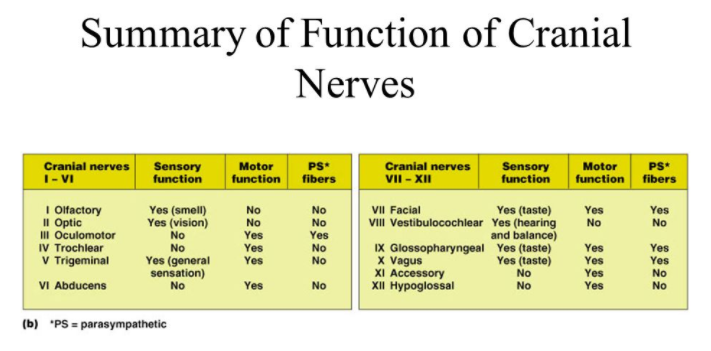
The cranial nerves which are exclusively sensory in function are
A. Olfactory and optic
B. Optic and oculomotor
C. Hypoglossal and optic
D. Hypoglossal and olfactory
Answer
499.8k+ views
Hint: The type of nerves that connect the brain to various parts of the head, neck, and trunk are referred to as cranial nerves. There are twelve pairs of cranial nerves out of which the olfactory (cranial nerve I) and the optic nerve (cranial nerve II) are considered as the nerves that perform sensory function exclusively.
Complete answer: The olfactory nerve (CN I) is the first and shortest of the cranial nerves. It comprises the nerves that perform the function of transmission of smell related sensory information to the brain. The aroma of the molecules we inhale stimulates the nerve signals that are then sent to the forebrain areas associated with the retention and identification of the smell inhaled.
The optic nerve (CN II) is the second cranial nerve that comprises vision-devoted sensory nerves.
The rays of incident light entering into the eyes are received by the rods and cones present in the retina of the eyes.
This information is transferred to the optic nerves through the retina thereby transmitting it to the back part of the brain that consists of the visual cortex.

So, Option (A) is correct
Note: The cranial nerves are counted sequentially from the front of the brain to the rear, about their location. There are 12 pairs of cranial nerves in the base of the skull that originate from the underside of the brain and travel into the foramina.
Cranial nerves I, II, and VIII are pure nerves of a sensory nature. Pure motor nerves are the cranial nerves III, IV, VI, XI, and XII.
Mixed sensory and motor nerves are the cranial nerves V, VII, IX, and Z.
Complete answer: The olfactory nerve (CN I) is the first and shortest of the cranial nerves. It comprises the nerves that perform the function of transmission of smell related sensory information to the brain. The aroma of the molecules we inhale stimulates the nerve signals that are then sent to the forebrain areas associated with the retention and identification of the smell inhaled.
The optic nerve (CN II) is the second cranial nerve that comprises vision-devoted sensory nerves.
The rays of incident light entering into the eyes are received by the rods and cones present in the retina of the eyes.
This information is transferred to the optic nerves through the retina thereby transmitting it to the back part of the brain that consists of the visual cortex.

So, Option (A) is correct
Note: The cranial nerves are counted sequentially from the front of the brain to the rear, about their location. There are 12 pairs of cranial nerves in the base of the skull that originate from the underside of the brain and travel into the foramina.
Cranial nerves I, II, and VIII are pure nerves of a sensory nature. Pure motor nerves are the cranial nerves III, IV, VI, XI, and XII.
Mixed sensory and motor nerves are the cranial nerves V, VII, IX, and Z.
Recently Updated Pages
Express the following as a fraction and simplify a class 7 maths CBSE

The length and width of a rectangle are in ratio of class 7 maths CBSE

The ratio of the income to the expenditure of a family class 7 maths CBSE

How do you write 025 million in scientific notatio class 7 maths CBSE

How do you convert 295 meters per second to kilometers class 7 maths CBSE

Write the following in Roman numerals 25819 class 7 maths CBSE

Trending doubts
A boat goes 24 km upstream and 28 km downstream in class 10 maths CBSE

The Equation xxx + 2 is Satisfied when x is Equal to Class 10 Maths

What are the public facilities provided by the government? Also explain each facility

Difference between mass and weight class 10 physics CBSE

SI unit of electrical energy is A Joule B Kilowatt class 10 physics CBSE

Why is there a time difference of about 5 hours between class 10 social science CBSE




